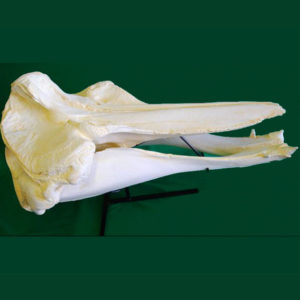All items sold on this website are polyurethane resin replicas, made in USA. No real or natural bone is available on this site.
B. bairdii Skull Replica measures 59x31x20 inches. B. bairdii Skull Replica is museum quality polyurethane cast. Made in USA. Cast of an original California Academy of Sciences specimen male skull. 2-part skull (separate cranium and jaw). Oversize shipment – Please call 509-951-3557 for shipping and crate quote.
Bairds Beaked Whale or Berardius bairdi is found in the northern Pacific Ocean, the Sea of Japan and the southern part of the Sea of Okhotsk. Specimens have been recorded as far north as the Bering Sea and as far south as the Baja California peninsula.
Bairds Beaked Whale or B. bairdi is the largest of the beaked whales, has an estimated population around 30,000 individuals, sometimes reaching a maximum length of 42 feet or 12.8 m. This species may be the only large beaked whale found in the North Pacific.
Bairds Beaked Whale or B. bairdi are unique among toothed whales in that most species only have one pair of teeth. The teeth are tusk-like, but are only visible in males, which are presumed to use these teeth in combat for females for reproductive rights.
In females, the teeth do not develop and remain hidden in the gum tissues. B. bairdii have two pairs of teeth, the first pair protruding 9 centimeters from the extended lower jaw. The second pair is roughly 20 centimeters behind the first and grow to about 5 centimeters. The teeth of the female are slightly smaller than those of the male.
B. bairdii are a blueish grey color, often with a brown tinge. Their undersides are usually lighter with three patches of white on the throat, between the flippers, and near the navel and anus. These spots range in size from barely visible to an almost continuous stripe across the belly. Two grooves run along the underside of the jaw in a wishbone shape. Females tend to be lighter in color than males, who often have tooth scars on their beaks. B. bairdii have triangular fins about 30 centimeters tall and set far back on the body.
The throats of all beaked whales have a bilaterally paired set of grooves that are associated with their unique feeding mechanism, suction feeding. Instead of capturing prey with their teeth, beaked whales suck it into their oral cavity. Suction is aided by the throat grooves, which stretch and expand to accommodate food.
While diving, they generally feed between depths of 2,500 and 4,000 feet on deep-sea and open-ocean species of mackerel, sardines, and saury, as well as crustaceans, sea cucumbers, squid, lobster, and octopus. Their tongues can move very freely. By suddenly retracting the tongue and distending the gular (throat) floor, pressure immediately drops within the mouth, sucking the prey in with the water. Dietary information is available from stomach contents analyses of stranded Bairds Beaked Whales or Berardius bairdi and from whaling operations.
Most B. bairdii reach sexual maturity when they are about 9.4 meters long for males and 10 meters long for females. They mate in mid-summer in warm waters near Japan and California. The gestation period is thought to be approximately ten months, though pregnancies of up to 17 months have been reported. Calves are born between late November and early May. A mother will usually produce one calf every three years that is about 15 feet long. The average lifespan is about 70 years.
Killer Whales are the primary predators and commercial whalers. Their threats include entanglement of fishing gear. Sound pollution threatens them by interrupting their normal behavior and driving them away from areas important to their survival. Sources of sound pollution include noise from shipping vessels, military sonar, and sonar used for seismic air guns used for oil and gas exploration.
Baird’s Beaked Whale Facts:
Conservation status: Least Concern (IUCN 3.1)
CITES Appendix I (CITES)
Scientific classification
Domain: Eukaryota
Kingdom: Animalia
Phylum: Chordata
Class: Mammalia
Order: Artiodactyla
Infraorder: Cetacea
Family: Ziphiidae
Genus: Berardius
Species: B. bairdii
Binomial name: Berardius bairdii






